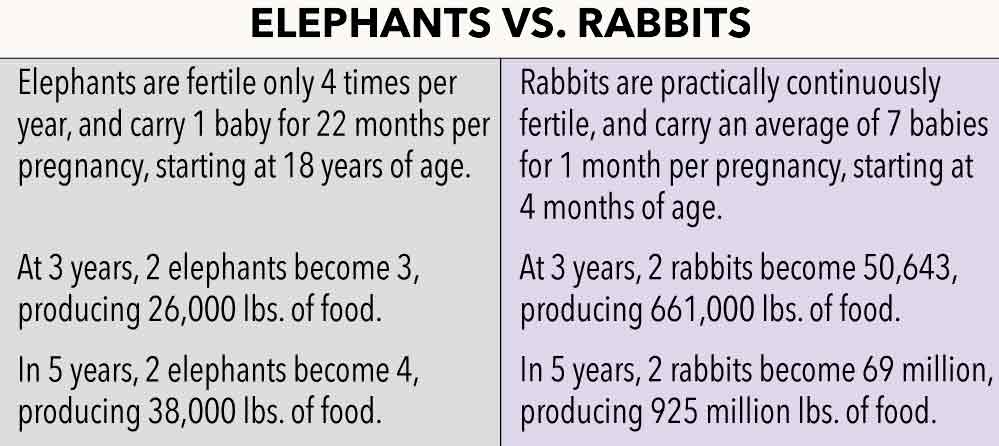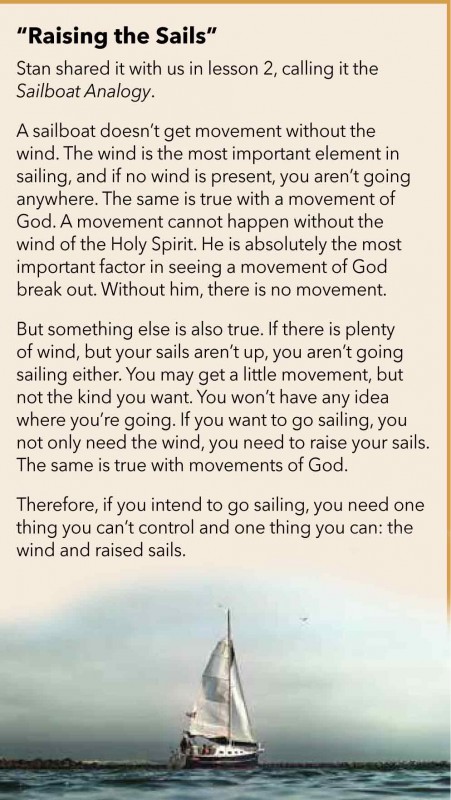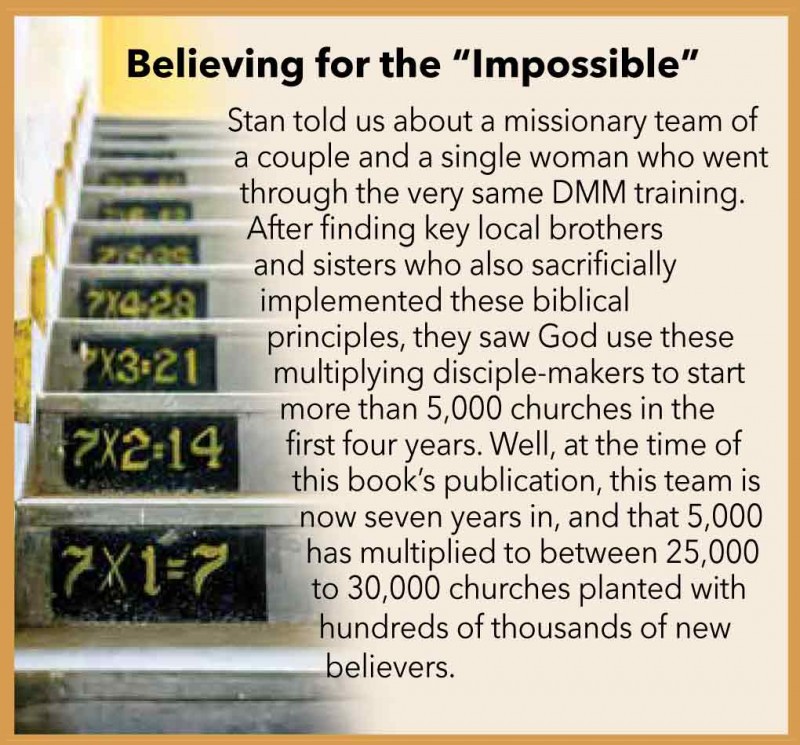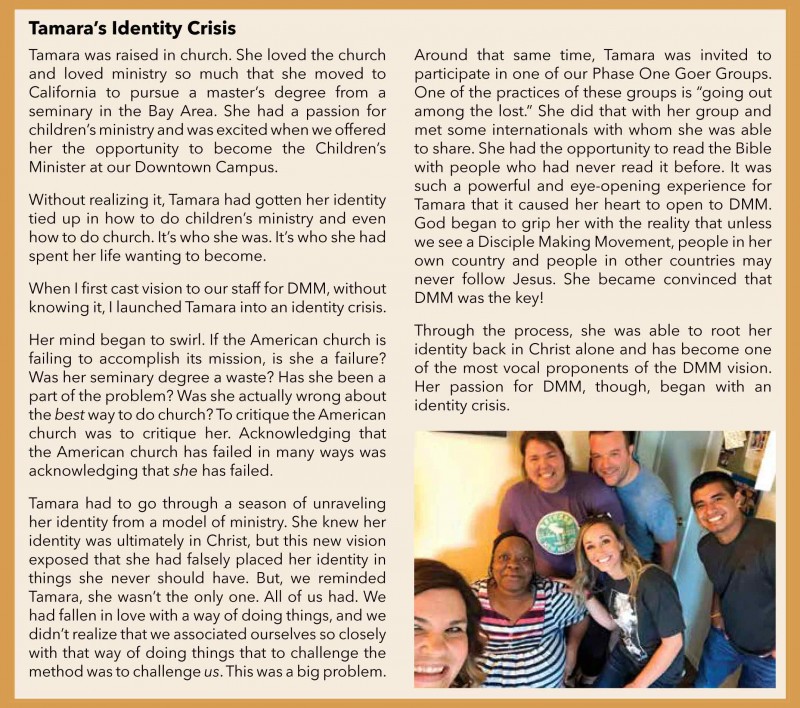From Big to Small— for a Big Movement

If you were to walk into our church during the first 10 years and then walk in now, you’d probably feel as if you’d entered two totally different churches. And you’d be right.
The focus of this story played out in my book, From Megachurch to Multiplication. This is a story about our church’s journey from being one of the fastest-growing churches in the United States to a church now focused primarily on catalyzing movements.
At our first meeting, we had 12 in our living room. We prayed that the Lord would allow us to help 10,000 people commit their lives to Christ in 10 years. On our 10 year anniversary in September of 2017, we celebrated 13,337 people who indicated they had committed their lives to Christ and 6,756 who had been baptized.
During year eight, I started asking the Lord, What do you want our vision to be for the next 10 years?
That’s when I stumbled upon WIGTake.
As I was reading David Garrison’s book Church Planting Movements: How God Is Redeeming a Lost World, these two sentences leaped off the page at me. “In the years that followed, Langston was joined by Calvin and Margaret Fox. Together they planned what it would take to reach all of the Kui with the gospel.” 1
According to the Joshua Project, (http://www.joshuaproject net) .a website that breaks down each country into its many different people groups, there are 1.6 million Kui. They were developing a plan to reach all 1.6 million!
I started asking the Lord, “In the next 10 years, do you want us to develop a plan to reach our whole people group with the gospel, as Langston and the Foxes did?”
I kept reading in Garrison’s book, and I continued to see this pattern of aiming to reach an entire people group. “In the late 1980s, three missionary families gathered a few Maasai believers and began to develop a plan to reach all of them.”2
David Garrison introduces the WIGTake question that these missionaries were clearly asking. He credits David Watson with initially forming the question for his work among an unreached people group in India. David Watson asked, “What’s it going to take to reach everyone in the people group?”
Even the disciples were told to develop a plan to reach entire people groups in Matthew 28:18–20.
Needless to say, the WIGTake concept, combined with Matthew 28, rocked my world. Eventually these conversations with God led to a complete change in the direction and vision for our church for the next 10 years.
This central WIGTake question led our Leadership Team into a season of prayer and fasting about the direction of our church for the next 10 years. According to the Joshua Project, the United States has 488 people groups who live here.. The two largest people groups listed are the ones most Americans belong to, and the total of those two people groups is approximately 225 million.3
We knew that aiming to tell the good news of Jesus to everyone in our people group is what John Langston and the Foxes would aim to do if they were sent here as missionaries.
What would it take to reach the 200 million in our people group in 20 years (assuming 25 million are already believers)? I remember the day we sat down as a Leadership Team and talked about this and sought to develop a plan for the next 10 years!
Our WIGTake became: What’s it going to take to reach 1,000,000 in the next ten years so that we’re on track to reach 200 million in 20 years? As we thought about the number of campuses, buildings, staff, and money that would be required, we tried to come up with a calculation.
The average cost per baptism in the typical American church is $1.5 million. Feel free to gasp in disbelief.
We calculated that each baptism at eLife costs $5,000. Using our current model, we realized that it would cost: $5,000 X 1,000,000 PEOPLE = $5,000,000,000
(5 billion dollars)!
It took us about 30 seconds to toss that idea.
Based on his research, John S. Dickerson concludes in his book The Great Evangelical Recession, 6 Factors That Will Crash the American Church and How to Prepare: “If we want to rebuild and restore a culture of discipleship, we have no choice but to release the way American church was done in the 20th century.”
Looking at our “1,000,000” number that we had written on a whiteboard, we asked if there was a strategy that could reach all of these people? As our team sat there, we knew…we had heard the stories…we had been reading books about them for months. We had even visited some of these places. But the stories weren’t from America. They were from India, Africa, and China.
Millions were coming to Christ. We couldn’t help but ask, Could God do the same thing here?
I remember receiving the annual report a few years ago from one of our church’s mission partners in India. According to the opinion of an outside research team, this movement had grown to between eight to 12 million baptized believers meeting in hundreds of thousands of house churches over the last 25+ years.
Remember the cost per baptism in the United States? $1,500,000. Guess what the cost per baptism is in this movement—66 cents.
During this process of prayer and fasting, I asked the Leadership Team to read three books. The Great Evangelical Recession, Spent Matches and Church Planting Movements. With these books and stories in mind, we knew there was a strategy that could take us to the million. It’s the strategy Jesus encouraged in the Gospels and the early church implemented in Acts.
DMM stands for Disciple Making Movement. This is a strategy that can lead to seeing God start a Church Planting Movement (CPM). Those who implement a DMM strategy measure success differently than the typical church in the West does. Success can be summed up in two words: generational discipleship. They measure whether disciples are making disciples who make more disciples who make more disciples. They don’t plant churches hoping to get disciples (which is what I did). They make disciples, and from those disciple-making efforts, churches are planted. It’s multiplication, not addition.
There are more than 1,035 active movements in the world today, and the average size of these movements is more than 75,000 believers.
The average size of a church in these movements worldwide is 18 believers, according to Justin Long of Beyond.
What are DMM churches like? One leader in a movement overseas said that he’d put these churches up against any church in the West, in terms of commitment to God’s
Word, church health, courage in the face of persecution or any other category.
Beyond, a missions-sending organization, has posted a series of videos corresponding to the CPM steps, which I’ve found helpful in giving an introduction to this strategy. You can see them at beyond.org.
After much prayer and discussion, the Leadership Team was united in the belief that the Lord wanted us to pursue a Disciple Making Movement strategy in the next 10 years. The next step was announcing it to the entire church at our upcoming 10 year anniversary service on September 10, 2017. We decided in the months leading up to the anniversary to do a few sermon series that would help the church understand the reason for this vision shift.
I told the church about our friends around the world who are seeing millions come to Christ. I emphasized that DMM invites every ordinary believer, not just pastors, to be a disciple-maker and church planter. I explained further how believers often refer to themselves as church planters in these movements around the world. They’ll say, “I’m a taxi driver to provide for my family, but I’m actually a church planter.” Or, “I’m a schoolteacher to make a living, but I’m actually a church planter.” They see it as their job to make disciples and to see churches planted.
Elephants vs. Rabbits
Imagine you have been asked to feed a village that is running out of food. Would it be better to give the people in the village two adult elephants or two infant rabbits? What would you say?

Rabbits reproduce so quickly and elephants so slowly that elephants could never produce as much food as the rabbits, not that you’d want to eat either, though!
Now think about this in terms of church strategies. Elephant churches are traditional American churches. They’re big, usually have a building, require lots of money and a staff. They are hard to reproduce. Rabbit churches are small, often meeting in homes. They are led by ordinary believers.
DMM author Jerry Trousdale said, “God bless elephant churches; they serve wonderful functions. But from every strategic perspective, mega-churches and even average-sized churches will never fulfill the Great Commission without a goal and plan to launch thousands of rabbit churches. Only a rabbit church has the ability to reproduce rapidly, thrive in a dangerous environment, and naturally facilitate obedience-based discipleship within every member.”4
But that left us asking, What do we do with the elephant?
The weekend after our 10 year anniversary, I shared with our church the desire to leverage every ministry in our church to help accomplish this new vision. That meant things were going to change!
I remember getting on my knees one Saturday afternoon and saying to the Lord, “What do you want us to do on the weekends? We know that weekends aren’t essential in DMM, but could our weekends be helpful? You’re our Senior Pastor, and we want to hear from you!”
Prayer and Testimony
The first thing he brought to my mind was what I’ve heard over and over again during the la 20 years. Henry Blackaby, author of Experiencing God, has said it, and my
dad reminds me of it all the time: prayer and testimony are the fuel of revival.
Obedience-Based Discipleship/Training
The second thing God brought to my mind is this: movements don’t happen unless people are reading, obeying, and sharing the Word of God. Jesus told his disciples in Matthew 28:20: “Teach these new disciples to obey.”In movements overseas, it’s called obedience-based discipleship.
In our context, the word teaching doesn’t have the connotation of obedience at all. A better word, perhaps, if we want to communicate that we desire to teach to obey, is the word train. Training implies obedience or application.
I’d encourage you to think about this: We in the West move on once we’ve heard a Bible passage, regardless of whether anyone has obeyed it. We move on once we’ve learned, not once we’ve obeyed. That’s knowledge-based discipleship. With obedience-based discipleship, you don’t move on until you’ve obeyed.
As I was praying that day about how to leverage our weekends, prayer, testimony and training were three of the things I sensed the Lord saying to me. Our Campus Pastors agreed with this emphasis and began to design their weekend services around these elements.
A DMM Coach
As eLife began venturing into the world of DMM, I knew I needed a coach. I met Stan Parks and we knew he would be able to help us get started, avoid common mistakes
along the way, and answer our questions as we ran into difficult situations.
We asked Stan what he wanted us to do first. He said he wanted to take us through a 12-week DMM Catalyst Training. This training was based on principles God had used around the world, and Stan would just pass on biblical lessons the Holy Spirit had taught him through David Watson, Victor John, many other movement catalysts and personal study of Scripture. (See “Believing for the “Impossible”on this page.)
I said, “Great! Can you send it to me?” He said, “Nope.”
I asked, “Why not?”
Stan made it clear that this training was not information to be transferred but biblical principles to be obeyed. Because I come from a knowledge-based culture, my tendency would be to read the twelve lessons and think, Okay, I’ve got this; let’s move on. But, again, this wasn’t information; these were biblical principles he wanted to coach us to obey! That means you don’t even need to look at lesson two until you’ve obeyed the passage from lesson one. Stan told us that the Holy Spirit would speak to us as we took a fresh look at these Bible passages; he didn’t want to interfere with what the Holy Spirit wanted us to hear and obey.
Stan wanted us to see the DMM principles in Scripture so we’d be dependent on God, not on him.
Stan introduced the notion of the seven elements of “raising the sails” in our DMM training. He explained that these elements are found consistently in the lives of
ordinary believers who are successfully making disciples in these movements all over the world.

Multiply Extraordinary Prayer
One element in “raising the sails” is Multiply Extraordinary Prayer. Stan said, “Your prayer life now is ordinary for you. Add something to it to make it extraordinary for you. Keep repeating the process.” So I issued a challenge. In a message to our staff, I said, “Let’s start praying every weekday for an hour rather than just once a week, much
like they started doing in the 1857–1858 Prayer Revival under the leadership of Jeremiah Lanphier.” After that, we started praying for one hour through lunch every day and for four to five hours every Sunday night.
Jerry Trousdale, author of The Kingdom Unleashed, wrote,
If we are going to see movements in the Global North, we will need to see a new, ongoing commitment to serious, intense, persistent prayer for God to open heaven, to raise up disciple makers and church planters, to guide us to His people of peace, and to empower our work. Without that, there will be no movements.

Go Out Among the Lost
Another element in “raising the sails” that Stan introduced to us is Go Out Among the Lost. Inspired by a story in Steve Addison’s book What Jesus Started, I contacted a friend of mine who was a Lubbock police officer and asked, “What neighborhoods are known to be the most dangerous in our city?” We were prompted to ask this question because one of the DMM principles we learned is to expect the hardest places to yield the greatest results and Steve shared a story about this in his book. We started prayer walking one of those difficult neighborhoods. See the story, “Knocking on Doors” in the article “Reaching the “PIPSY” People.
Casting Vision
Nine months prior to our 10 year anniversary, we started casting vision to people in our church whom we thought might be interested in participating in DMM training.
One of the great tragedies of the American church model, and it’s happened at our church too, is an attitude that results in suppressing the gifts, ambitions and callings of
ordinary believers. Churchgoers don’t typically hear the term disciple-maker and think, “that’s me!” or hear the term church-planter and think, that’s me!”
A great example comes from one of eLife’s DMM Church Planters. We cast vision to him, trained him, and then sent him out to train his team. Once he trained the team,
he and his team left our church and began to function as a DMM church. I asked him later how it was going. He said, “I feel like we were set free.”
We’ve got to recover the “culture of empowerment” of ordinary believers that was evident in the first-century church. Pastors and leaders, I implore you to join me in setting believers free to make disciples and plant churches!
The Transition: Counting the Cost
Transitioning a church to DMM is going to cost you. Just as Jesus encouraged the crowd in Luke 14 to count the cost before deciding to become his disciple, you need to
count the cost before engaging in DMM.
In The Kingdom Unleashed, David Broodryk, a pastor who embraced DMM, describes the process of pursuing DMM this way:
I really do think that entry into DMM is a death experience: unless the seed falls to the ground and dies, it can bear no fruit. But the problem is, you can’t risk failure without that; risking failure in itself is a sort of death experience. If who you are is dependent on whether this thing works or fails, then you will never take a risk. But if your identity is in Christ, then you say, “I’m going to try this; if it works, great, He gets the glory; and if it doesn’t work—well, it didn’t work, but I am still secure in Him.
Our entire staff experienced an identity crisis.

Pursuing DMM will cost you financially too. A ton of money walked out of our church.
I never thought I’d lead a church where we’d be celebrating people leaving. But, in truth, sending people out on a disciple-making mission is far more exciting than seeing
people sit comfortably in a chair each weekend, far from the people who need Jesus the most.
While losses can be painful, the good news is: God is pruning you so that you can bear more fruit. You will struggle with doubt, and likely face discouragement when people you’ve done ministry with for years decide to move on.
Jerry Trousdale warns us of the opposition that can come when we follow the Lord into a disciple-making vision: DMM practitioners have been ostracized from their denominations, have lost friends, have been vilified and slandered, all from within the Christian community.5
After casting vision for DMM and training people, we sent them out among the lost to places where Jesus had led them to go. Our DMM churches use the acronym PIPSY (derived from Matthew 25:31-46) to describe the places Jesus often leads us to go.
Going to PIPSY Places
The first P stands for “poor.” The I stands for “international.” The second P stands for “prisoner.” The S stands for “sick.” The Y doesn’t stand for anything— it just turns PIPS into an adjective.
Our teams have borne the most fruit going to PIPSY places to make disciples. See the article, “Reaching ‘PIPSY’ People.” Here is one story of what Jesus
has done through our outreach to PIPSY people.
The Sick
Jesus told his disciples in Matthew 10 and Luke 10 that when they entered a new area, they were to heal the sick and announce that the kingdom of Heaven was near. Some of our teams have gone to hospitals to pray for the sick.
On one occasion, while doing this, one of the teams got lost while trying to get back and ended up in the burn unit. They met a family who had a loved one in that unit and the family wanted our team to pray with him. One of the family members pressed the button to get in and convinced the nurses to allow our team to come in to pray with the patient. They knocked on his door and more family members were sitting at his bedside.
The burn victim was in his sixties, and he had been injured a few days earlier in some kind of grease fire in his kitchen. The fire resulted in major burn wounds on his chest and arms, so bad that he couldn’t move his arms.
One of the members of the team, said, “I believe Jesus Christ has the power to heal you, and we’d like to pray for you. Is that okay?” The man nodded his head. They gently put their hands on the bandages on his arms and started praying. After the prayer was finished, one of the team members asked him, “How does it feel?”
The man lifted up his arms and started moving them around, and the family collectively gasped. Then he raised his arms above his head, and family members began crying right there by his bedside.
The Relaunch
When we announced the 1,000,000 in 10 years vision on our 10 year anniversary, all I could really even envision was “transition.” We were a large church and we were
transitioning to a new God-sized vision that would leverage everything at our church to reach the million.
And what happened in the two years following our “transition” is that people caught the vision we were casting! Hundreds went through our DMM training and some of those began to form DMM churches that met in their homes (much like the 50+ church planters we sent out on the 10 year anniversary). And those that we sent out began to pursue the lost, not by inviting them to Experience Life, but by inviting them and their family/friends to read and apply the Bible together in their home. The hope was that these Discovery Groups would commit their lives to Christ together and that many churches would be planted.
On the other hand, many others in our church prayed about it and sensed the Lord leading them to join other great churches in town. And by the way, we didn’t consider this a loss.
As a result of this “transition,” we were getting to both directly and indirectly “send” many people out from our church to the next assignment God had for them.
In the years following the 10 year anniversary, we began to realize that a day could come soon where our “leveraged” elephant ministries wouldn’t be needed anymore. They had accomplished the purpose for which they were leveraged. Namely, raising up workers to join us in making disciples and planting churches to reach the million!
We realized about 1.5 years into the “transition” that the Lord was, unbeknownst to us, actually using the “transition” to help us “relaunch” Experience Life as a network of DMM churches across the country. This wasn’t really on our radar at the beginning. While we thought it could be a possibility one day, it wasn’t something we were aiming for or setting goals toward. And we thought “one day” might be 10 or 20 years from now or more. We were just trying to follow the Spirit’s leading in making a “transition” and trusting that He’d then show us the next steps to take. And He did!
In the month before our 12 year anniversary, almost two years into the transition, our leadership met and we believed the Lord had made it clear that He wanted us to
“relaunch” soon. In order to do that well, we wanted to once again reorient the way we did our weekend gathering to give everyone the opportunity to come along. Instead
of sitting in rows of chairs, we put out tables and had a staff member sit at each table. And for six weeks, during the Sunday morning gathering, we modeled DMM church
and cast vision for being sent out together to form DMM churches across our city. Those six weeks were so powerful!
We were determined that if the Lord was leading us to “relaunch,” we were going to make sure everyone had the opportunity to understand the vision, ask questions, take time to pray and join us for the journey if that’s how the Spirit led. After those six weeks, we “officially” relaunched into DMM churches across our city and ceased having gatherings at our Downtown Campus on Sunday mornings. There were still many of us “gathering,” just not in a church building. Rather, we were gathering across our city in many homes. And these DMM churches weren’t just “gathering” in the traditional sense to sing some songs and hear a sermon. Their “gatherings” were more like missionary strategy meetings where they were praying, devoting themselves to Scripture and strategically planning how to take thegospel to parts of our city who need it most with the hope of seeing reproducing churches planted there.
One 16-year old girl that attends one of these DMM churches was asked by someone to describe the DMM church meeting. I loved her response. She said, “It’s a lot like the Book of Acts. Just go read that and you’ll understand.” There’s a lot of truth in that, though, from my own experience of being involved! In addition to gathering in homes on a regular basis, all of our DMM churches gather together at our Downtown Campus for prayer, testimony and training to encourage one another and celebrate what God is doing across our city (although not weekly, and not on Sundays).
During those six weeks of preparation for “relaunch” meetings, we were also encouraging our staff to begin forming or joining DMM churches. Many of them had not been in one yet because we still had gatherings on the weekends and most of the DMM churches met on Sunday mornings.
As our staff got involved in different DMM churches, you should’ve heard their reactions:
“How have I missed this all of my life?”
“How could I ever do anything else?”
“How could we ever go back?”
“How do we help everyone experience this?”
I think I can speak for most people who are involved in DMM churches by saying it’s one of the most unbelievable things I’ve ever been a part of. In so many ways it’s what I’ve always longed for in church. Not that I didn’t love our church, I did! It’s just what I pictured when I read the New Testament but felt like I’d never experienced. It’s what I heard about overseas but never truly understood.
On an average week, just my DMM church alone will talk to almost as many lost people as our megachurch would receive as first-time guests on a weekend in our heyday. And there’s just 35 of us (including kids). It’s amazing what a small group of sold out, on fire disciplemakers can do when they strategize together and go out among the lost to make disciples and plant churches.
After forming my own DMM church and experiencing it for a few months now, I can say I better understand why the Holy Spirit would’ve used our transition to lead us to “relaunch.” I can see now how a church like Experience Life could make more disciples and plant more churches by focusing on training, coaching, and resourcing a network of many churches rather than trying to build one big megachurch of our own (Eph. 4:11-12). And that’s what we’re up to now. We’ve started churches not only in Lubbock, but also in other West Texas cities, other cities throughout Texas and even other cities around our country.
In the two years since our transition, we’ve had the privilege of training hundreds of pastors from across the country (and even in other countries). And many of these pastors sense the Spirit of the Lord leading their church on a similar journey and many are joining us. We could never have dreamed this up! People’s hunger to experience (and obey) what they’re reading in the New Testament is growing. So many feel convicted, like us, that it’s time to take the Great Commission seriously and not just talk about it, but get out and do it!
It’s so exciting having many churches join us for the journey. It affirms so much of what the Holy Spirit has told us to do because He appears to be speaking to many other churches in the same way.
And in looking back, of the 12 years that Experience Life has existed, I really believe these last two have been the most exciting and impactful!
I hope our story will inspire you to be led by the Spirit because He will take you to better places than anything you could’ve dreamed up. And you may not even have a framework for where He’ll take you now. But if you follow Him, He’ll show you just what to do. And chances are, He’ll do infinitely more than you could ask or imagine (Eph. 3:20-21). Just like he continues to do with us.
Our vision to see 1,000,000 disciples made in 10 years was never just about eLife. We know it is going to take many churches and organizations joining together to reach the million and ultimately the 200 million in our people group who need Jesus. If God is giving you a vision for movements in America as well, then let’s serve together! If there’s anything we can do to help you or your church with the journey you’re on, email us at info@ wigtakedmm.com. We’d be glad to help. Wouldn’t you love for a movement to break out in your region?









comments